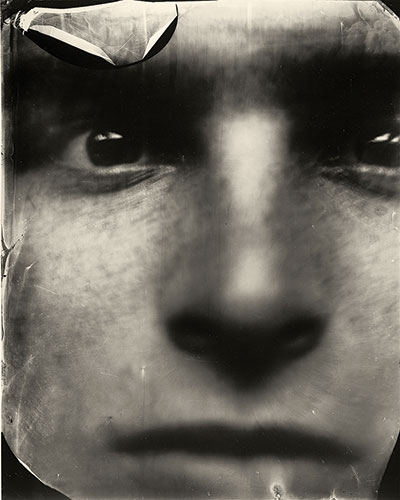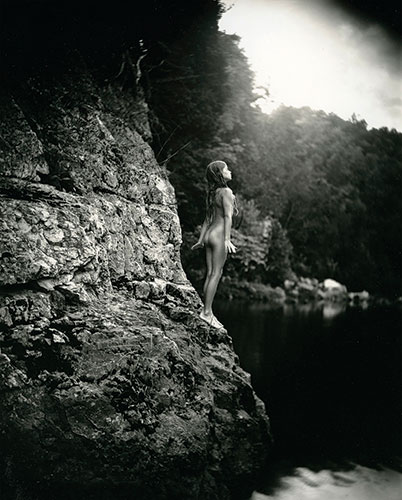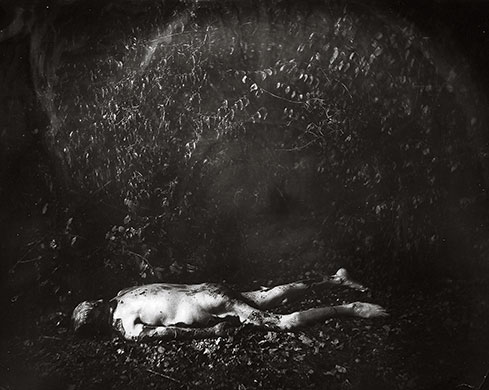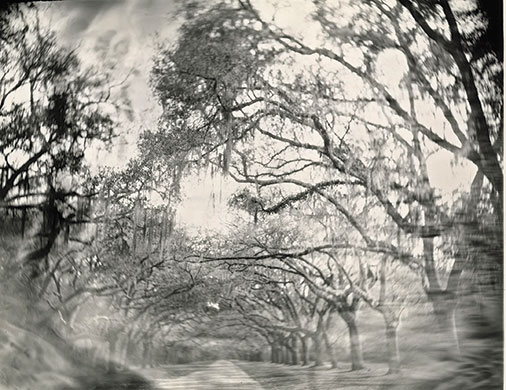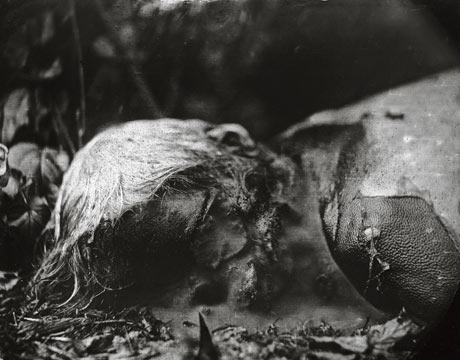
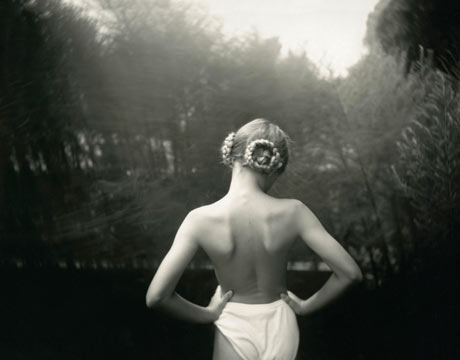
Sally Mann The Naked and the Dead. Article by Blake Morrison, The Guardian 29th May 2010
Other Sally Mann posts here and hereSally Mann The Naked and the
Dead. Article by Blake Morrison, The Guardian 29th May 2010
From close-ups of rotting corpses to
those controversial portraits of her children baring all, Sally Mann has a gift
for provocation. Blake Morrison asks her why she likes 'pushing buttons'
Sally
Mann admits to being a little exasperated. Described by Time magazine in 2001 as "America's
best photographer", she is nothing if not adventurous, ranging widely in
subject matter and technique, but to most people she is known, if at all,
for just one thing: "Oh, she's the one who photographed her children
naked."
It's exasperating in several ways:
because the photographs in question - published in the book Immediate Family,
in 1992 - made her famous for the wrong reasons; because critics exaggerated
the intimacy of the photos at the expense of their artfulness; and because the
American religious right accused her of pornography when her camera was
capturing beauty and transience. "I've counted," Mann says. "Out
of the 65 photos in the book, only 13 show the children naked. There was no
internet in those days. I'd never seen child pornography. It wasn't in people's
consciousness. Showing my children's bodies didn't seem unusual to me.
Exploitation was the farthest thing from my mind."
In Britain,
perceptions of Mann are particularly skewed because she has never had a solo
exhibition here. That omission will be put right next month, at the Photographers' Gallery in London, with a
show representing different phases of a career that began in the 1970s. The
Immediate Family series is complemented by haunting studies of the grown-up
faces of her children, Emmet, Jessie and Virginia, all now in their 20s. Mann's
identity as a southern artist (she grew up near, and still lives among, the Blue Ridge
Mountains of Virginia) is expressed in a series of landscapes,
focusing on swamps and trees. Most challenging of all are her photographs of
decomposing bodies as they melt into and meld with the land.
Mann has a gift
for provoking strong reactions ("I like pushing buttons") and her
pictures of rotting corpses certainly do that. She took them at the University of
Tennessee's anthropological facility at Knoxville, aka the
"body farm", where human decomposition is studied scientifically. The
bodies are mostly left in an outdoor setting and lie there for months or even
years. In Steven Cantor's 2006 television
documentary about Mann, she is observed happily wandering from
cadaver to cadaver, prodding this body part and stroking that one, unfazed by
the maggots and reek of decay.
"Death makes
us sad, but it can also make us feel more alive," she says. "I
couldn't wait to get there. The smell didn't bother me. And you should see the
colours - they're really beautiful. As Wallace Stevens says,
death is the mother of beauty."
Mann called the
series What Remains, her point being that death is not an end, that nature goes
on doing its work long after the body has become a carapace. When her exhibition
of that title opened in Washington in 2004, most reviewers got the
point: "But not the woman in the New York Times, who freaked out and
called the photos gross." Mann was surprised to see an art critic using
the vocabulary of a 10-year-old, but not by the underlying prejudice:
"There's a new prudery around death. We've moved it into hospital,
behind screens, and no longer wear black markers to acknowledge its presence.
It's become unmentionable."
More remarkable
was the fact that no one questioned her right to publish the photos;
there had been endless sermonising about her portrayal of her children, but
this time there was none. "If there's any time when you're vulnerable,
it's when you're dead. In life, those people had pride and privacy. I felt
sorry for them. I thought if they knew I was taking photos, without them having
a chance to comb their hair or put their teeth in, they'd die of shame. So I expected
critics to ask: is this right?
"I was ready with my answer: all these people had signed release forms. I've done the same now, donated my body for research. But then I discovered that some of the corpses were street people who hadn't signed releases. And of course even those who did sign probably thought the photos would be scientific, not artsy-fartsy. So though I was given a free hand - 'Go on,' they said, when a fresh batch arrived, 'unzip the body bags and get them out' - I decided to keep the subjects anonymous. I didn't want to aestheticise them, either. It was important to treat them with respect."
There are various
sources for Mann's preoccupation with mortality. The shooting of an escaped
prisoner in the grounds of her farm in Lexington. The death of her greyhound,
Eva, whose bones - retrieved from the cage in which Mann had buried her - she
later photographed ("That was when I learned how efficient death is. After
14 months, the skeleton had been picked completely clean"). Or, years
before, the death of her father, for which she was present and which set her
wondering, "Where did all of that him-ness go?" Even the photographs
of her children are littered with memento mori: a dead deer in one, a dead
weasel in another.
In truth, though,
Mann's lively obsession with death - her capacity to be unsqueamish about it
while seeing its thumbprint everywhere - originated way back in early
childhood. Her father was a country doctor who had seen his share of death and
who liked to say there were only three subjects for art: sex, death and whimsy.
He was himself an artist in his spare time, and his whimsical creations
included a man with three penises (Portnoy's Triple Complaint) carved from a
tree trunk. It was an unconventional, rural childhood, middle class but
bohemian: no church, no country club, no television. Mann describes herself as
a "feral child", running naked with dogs or riding her horse with
only a string through its mouth.
She always knew
she would be an artist of some kind, and after marrying in her teens,
getting a good degree and studying creative writing, she settled on photography,
which she'd taken up while at school. The assignments were far from glamorous -
"The manager of Pizza Hut shaking hands with a prize college athlete: I
did that sort of thing for 10 years" - but she scraped a living from them
and nurtured more experimental work on the side. Then came an exhibition, a
book called Second Sight,
and fellowships from the Guggenheim Foundation and National Endowment for the Arts. While raising
her three children in the 1980s, she worked to the principle that art is about
the ordinary and lies right under our noses. Her reputation was steadily
growing, but New York seemed a long way away ("It didn't help my career to
be living in Appalachia") and she remained comparatively unknown until
Immediate Family became a publishing sensation in 1992.
It's not a period
she likes to dwell on, but for a series of forthcoming lectures she has
forced herself to look back and ask the questions her critics have asked.
"Knowing what I now know, would I have taken the photos? Probably.
Would I have released them differently? Maybe. Do I regret them?
Absolutely not. I knew they were hard-hitting and that publishing them was
a gamble, but at another level I lived at a remove, in a state of naivety, and
the photos - many of them taken by the river where we spent vacations - seemed
perfectly natural. Had they destroyed my relationship with my children, it
would have been too high a price to pay. And, of course, I kept hearing
that the photos would screw them up once they were older. When they were going
through the usual bumps teenagers go through, I did sometimes wonder: is
this because of the pictures? But I don't think they were affected much at
all."
Mann has always
described these photos as a collaboration - Jessie, in particular, seems
to revel in the role of model, whether wearing a pearl necklace or brandishing
a candy cigarette. Signs of upset, injury and danger abound - a bloody nose, a
wet bed, a skin rash, an approaching (plastic?) alligator - but the children
came through OK and continue to pose for their mother.
The same goes for
her husband, Larry, who has been posing for Mann for more than 40 years:
"Larry has such confidence in my art," she says. "Far more
than I have." Working together on a series of studio nudes, Proud Flesh
(exhibited in the US last year), was, as she puts it, "a chance to spend
quiet afternoons together: no phone, no kids, two fingers of bourbon, the smell
of the ether, the two of us - still in love, still at work."
As well as these
abstract studies, which use the wet plate, or collodion, process and
make a virtue of the smears and distortions it can throw up, she has long been
compiling a much bigger series called Marital Trust, depicting Larry in a
variety of contexts - domestic, parental, sexual. Mann is well aware of how
radical these images are: the female artist gazing on the male model, rather
than vice versa. For now, though, she is holding them back: "This may
sound hubristic, but they're beautiful pictures, like nothing I've ever seen
before, and Larry looks terrific in them. But he's still working as a city
attorney and I don't want to embarrass him. Maybe after he's retired..."
For the moment,
she's at work on another project, about race. "It's a touchy subject, but
as a southerner you can't ignore our history any more than a Renaissance
painter can ignore the Virgin Mary. And it's impossible to drive down a road or
eat a vegetable or pass a church without being reminded of slavery." She
has previously explored the subject by photographing sites of civil war
battles, swamps through which slaves tried to escape their owners and the river
into which the body of the murdered black teenager Emmett Till was thrown in 1955 (a trigger
for the civil rights movement). Now she's taking portraits of men whose
ancestors were slaves.
Next year, Mann
will be 60, and she frets about becoming old news. The London exhibition is a worry,
too: if the current fashion is for coolness and cerebralism, will we Brits find
her too passionate, romantic, melancholy, sentimental? But the show has been a
success in Scandinavia. And there's the reassurance of knowing how many
photographs of Larry and the children she hasn't yet shown. "I think of it
as my aesthetic savings account - and I'm not talking about money. Whatever
fleeting discomfort I felt or caused while taking them, those photos are worth
much more. It's like having written Ulysses and put it under the bed. Forgive
me - that does sound hubristic."
